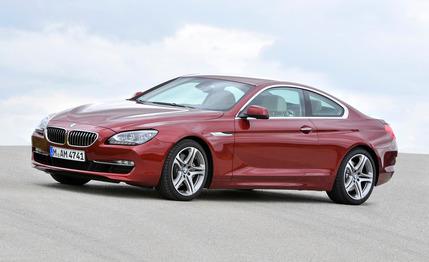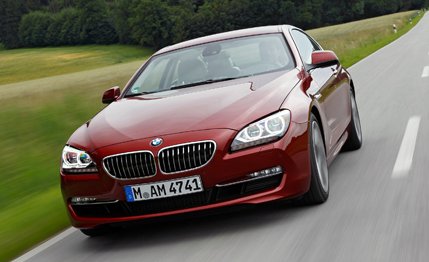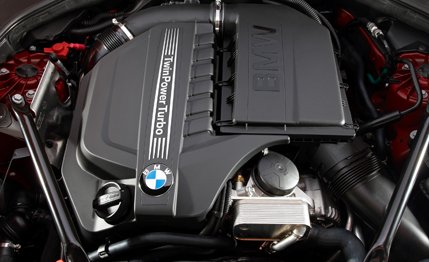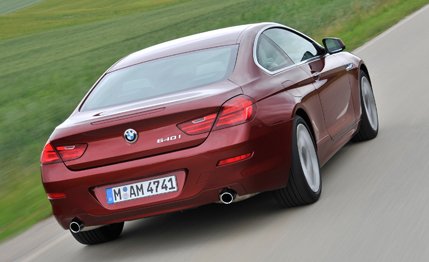
 First Drive Review
First Drive Review
BMW’s U.S. engine lineup is a model of flexibility and simplicity. The company fits its regular-production models with a naturally aspirated inline-six, a turbocharged inline-six, or a twin-turbocharged V-8. (Starting this year, the naturally aspirated six is being replaced by a turbocharged four-cylinder, and there’s also a low-volume 12-pot available only in the $138,000 760Li. But that’s it for complications.) All are smooth and powerful, among the best mills on the market. With those three basic packages, BMW powers the 1-, 3-, 5-, 6-, and 7-series, the X3, X5, and X6, and the Z4. We rarely complain about any pairing of powerplant and vehicle.
What we have in the 640i is a new combination of existing parts, but a combination that is in no way surprising. The BMW 6-series, freshly redesigned for 2012, shares most of its underpinnings with the 5- and 7-series sedans, both of which are available with a turbocharged inline-six. With ever-tighter fuel-economy standards looming, the 640i is as expected as someone ducking when you take a swing at his face.
And the 640i will be a very effective counter to the government’s move to ban horsepower and control fuel consumption. Thanks to the tall gear ratios at the top of its eight-speed automatic transmission, the 640 delivers an EPA-estimated 31 mpg on the highway. That gives this two-ton coupe the highest highway fuel economy of any BMW, aside from the 528i and Z4 sDrive28i, which use the firm’s new four-cylinder. Interestingly, 31 mpg is also 6 mpg better than that of the six-cylinder 740i. The 6’s city figure is 21, compared with 17 for the 7. Thank the 640’s two extra gear ratios—the 740i still has just six—and its newer, single-turbo engine.


Aren’t You Jealous? We Are
Turbocharged BMW six-cylinders are the violin-virtuoso, football-captain, Harvard Law–grad, charity presidents of the engine world. There’s simply nothing they don’t do well (even when burning diesel fuel, as offered in the X5 and 3-series.). There’s no reason to expect things to be different here. The engine in the 640i boasts exemplary smoothness and immediate grunt, accompanied by a sonorous vocal track that makes the 6er’s lowest available cylinder count seem anything but plebeian.
The 640i represents the first regular-production increased-output application of the N55 single-turbo inline-six BMW introduced last year (a higher-output package also is available as an option on the 1- and 3-series). Making 315 hp and 330 lb-ft of torque, the 640’s engine betters other N55’s by 15 horses and 30 lb-ft. Down one hair drier on the twin-huffed N54 that preceded it, this six nonetheless is virtually lag-free. Maximum torque is available from 1400 rpm to 4500, allowing the engine to yank the car forward at any speed. The pull to the 7100-rpm redline is so satisfying you’ll have a hard time letting up on the accelerator. On the autobahn, heavy rain and traffic alternately kept us from reaching the car’s 130-mph top speed (a governor loosened to 155 is on the options sheet), but we easily cruised at triple digits when the road was dry. Zero-to-60-mph sprints should take 4.8 or so seconds.
Opting for the smaller-engined 640i (as compared with the 650i and its V-8) otherwise changes the car very little—but pads the buyer’s mattress with $9400 in savings. The six-cylinder buyer forgoes a small amount of standard equipment—nicer leather, more seat adjustability, and one-inch-larger wheels, among the sacrifices—but it can all be added from the options sheet.


With the six-cylinder, the 6-series is about 200 pounds lighter than the V-8 car, but it still weighs north of 4000 pounds. It’s agile enough to dodge dithering hatchbacks on the autobahn but is far more satisfying in long sweeping turns than in tight mountain switchbacks. Oddly, for a car so closely related to two other very pleasing cruisers, the 5- and 7-series, the 6’s ride is harsh, regardless of what setting the adjustable suspension is in. We’ve previously complained about BMW’s new electric power steering here, here, here, here, here, here, and here (plus maybe one or two other times), so all we’ll say in this story is this: It’s not good.
Need Is Tough to Nail Down
When we first drove the conceptually similar (if more abundantly turbocharged) 740i, we came away with the impression that it was all the 7-series anybody needs. We’d say the same of the 640i, except that nobody needs a 6-series. Nobody exactly needs a 7-series, either, but as a sedan, it’s vastly more practical than a car with two fewer doors and an appendix of a rear seat.
As a big coupe, the 6 is a machine for broadcasting its owner’s greatness. Or at least that’s what we’d use it for. If you’re a bigger person than we are, though, and just want to look good, drive around surrounded by BMW’s best interior yet, and do so for as little money as possible, there’s no reason not to do it in a 640i. Except maybe—okay, we’ll say it again—the steering.

